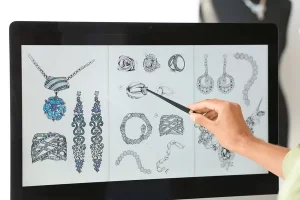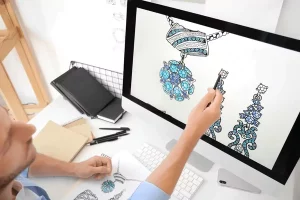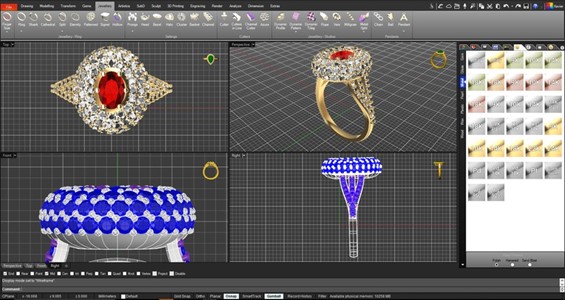
Beginners Guide to CAD in Jewellery Design
- Posted by 3.0 University
- Categories Jewellery Design
- Date May 23, 2025
- Comments 0 comment
Yes, we need to learn “What is CAD in Jewellery Design?”
Mostly due to the development of design technology—more especially, computer-aided design—CAD—the field of jewellery making has seen a fundamental transformation.
Given the fact that CAD provides complex and thorough representations and precise changes, which is rather different from conventional manual techniques, modern or contemporary jewellery designers depend much on it.
Creative possibilities are boosted, and the design process is streamlined, leading to more efficient production because of this technological change.
Newcomers to the field must grasp what CAD in jewellery involves because it blends artistic vision with technical skill, promoting fresh designs that cater to today’s consumer needs.
Aspiring designers can gain crucial skills and knowledge from online CAD jewellery design courses, even those in India.
Designers can take advantage of many benefits by incorporating tools found in CAD programs, like those in AutoCAD, ranging from design iteration flexibility to higher precision and detail.
This underscores how vital CAD is for building a successful career in jewellery design.
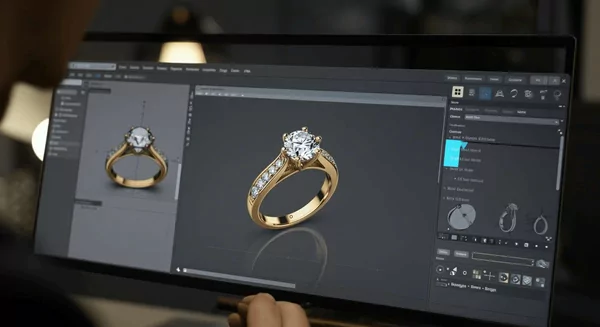
The Importance of CAD in Modern Jewellery Design
Why use CAD for jewellery design? The realm of jewellery design is evolving, and Computer-Aided Design (CAD) is a crucial component of that change altering appearance and manufacturing efficiency.
Designs were generally created by hand before CAD, therefore restricting their complexity and detail.
CAD programs let designers try out complicated ideas and make tiny changes. This accuracy is ; CAD software provides unparalleled precision, as has been noted [cited].
By seeing a design in 3D, designers can play around with different shapes and resources, boosting creativity and cutting down on prototyping costs.
By reducing waste and accelerating manufacture, CAD also makes the entire process more environmentally friendly and seamless.
The picture shows the wonderful detail that CAD can achieve, proving how technology can improve classic craftsmanship.
This change not only helps designers be more creative but also gets new jewellers ready for a tough market that values knowing how to use technology.
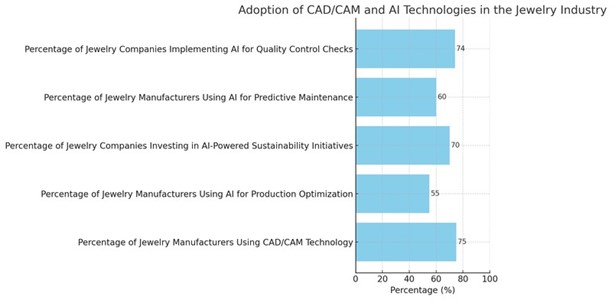
The acceptance rates of several CAD/CAM and artificial intelligence technologies among the jewellery sector are shown on this chart. While major investments are also being made in artificial intelligence for optimization, sustainability, predictive maintenance, and quality control, the focus is on a noteworthy portion of manufacturers using CAD/CAM technology.
Apart from that, the statistics shows a strong tendency toward the integration of these cutting-edge technologies, which emphasizes their relevance for improving sustainability and efficiency in the jewellery manufacturing.
CAD vs Manual Jewellery Design
Technology’s relentless march has, without a doubt, altered the terrain of jewellery design. This shift introduces a transformative approach that often feels quite different from older, more established techniques.
Manual jewellery design highlights the designer’s artistry and their uniquely creative perspective, really leaning into hand-drawn sketches and tangible prototypes.
On the other hand, computer-aided design, or CAD, brings a new level of accuracy and speed that just wasn’t possible before.
CAD lets designers build really complex models and create realistic images, which you can see in [cited], showing all the detailed work and different viewpoints you can get with the software.
Thinking about this, while manual methods really connect you to the heart of the craft, CAD makes the design process smoother, cuts down on wasted materials, and makes it easier to tailor things for clients—which is pretty important these days.
So, when upcoming designers are thinking about things like a CAD jewellery design course in India, it’s really important to think about the good things about both ways of doing things, understanding that each has its own place as jewellery making changes.
Aspect | CAD | Manual |
Productivity Increase with CAD | 39% increase | Baseline |
Cycle Time Reduction with CAD | 30% reduction | Baseline |
Custom Jewellery Production Methods | 79% of custom jewellery produced using CAD/CAM | 21% of custom jewellery produced manually |
Average Cost of CAD Software | $850 to $7,000+ | Not applicable |
Average Cost of CAM Systems | $2,000 to $20,000 | Not applicable |
Average Cost of CAD Design Services | $50 to $1,500+ per design | Not applicable |
Material Waste in Traditional Manufacturing | 5% waste with 3D printing | 20–30% waste in lost-wax casting |
Industry Adoption of CAD/CAM | Approximately 75% of the industry uses CAD/CAM | Approximately 25% of the industry uses manual methods |
Comparison of CAD and Manual Jewellery Design
Educational Pathways: CAD Jewellery Design Courses
The jewellery design world has been reshaped by Computer-Aided Design (CAD), now more accessible than ever for those just starting out. Thanks to online CAD jewellery design courses, mastering digital design’s nuances is possible right at home.
These courses typically delve into core areas like basic CAD methods, distinguishing between CAD and traditional jewellery design, and the array of software choices for newcomers.
Moreover, CAD jewellery design certification can greatly boost job prospects, serving as tangible evidence of skill in a field that’s increasingly prioritizing technical know-how.
For example, a successful course might include practical projects, challenging students to solve design problems and build a portfolio.
This learning route doesn’t just focus on creativity; it also gets students ready for a CAD jewellery design career, arming them with the needed tools to thrive in a fast-changing industry. A CAD interface image provides a clear look at how these skills translate to real-world use.
Here’s a list of courses for CAD jewellery design for beginners:
Institution | Course Title | Credits | Prerequisites | Software Used | Course Format | Location |
Parsons School of Design | Jewellery: CAD | 3 | None | Rhino CAD | In-Person | New York City, USA |
Gemological Institute of America (GIA) | Jewellery Design & Technology Program | Diploma Program | None | Rhinoceros, ZBrush | In-Person | Carlsbad, USA |
American School of Jewellery | Jewellery Computer Aided Design | 2 Weeks | None | Rhino 3D | In-Person | Hollywood, USA |
British Academy of Jewellery | 3Design CAD for Beginners | Short Course | None | 3Design | Online | London, UK |
World Academy of Design | Advanced CAD Professional (Jewellery Design) | 25 Hours | None | Gemvision | In-Person | Sharjah, UAE |
CAD Jewellery Design Courses Overview
Conclusion
The subject of jewellery design is evolving generally, and Computer-Aided Design (CAD) looks to be essential for both accurate manufacturing and creative innovation.
Knowing CAD in jewellery design not only benefits designers but also makes consumers delighted since they acquire bespoke products.
If you’re just beginning your career in this industry, enrolling in any specific courses—such as those provided in India—that teach you how to use sophisticated software for generating complex designs might be quite beneficial.
Looking at CAD against the more traditional hand-done techniques, you truly find some notable benefits. Changing designs is so much faster and simpler, which surely allows more creative space.
By visualizing their ideas and honing them before anything is actually produced, CAD helps designers make the whole design process much more seamless.
The picture clearly shows the possibilities inherent in this design. It demonstrates how CAD tools may produce reasonably useful yet aesthetically pleasing jewellery.
For designers, choosing a career in CAD jewellery design sounds like a wise choice and may most certainly be a fulfilling one.
3.0 University has partnered with IIG to offer specialized courses in Jewellery Design, Gemology, and Diamonds, complemented by real-time, hands-on industry experience under the guidance of seasoned mentors and industry experts.
This initiative is designed to meet the evolving demands of the industry for highly skilled and job-ready professionals.

